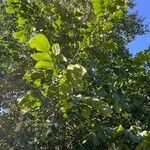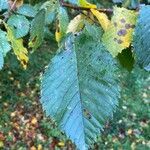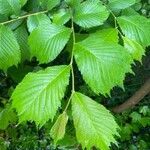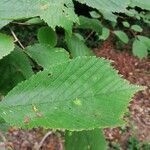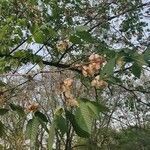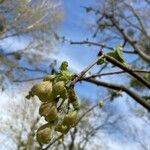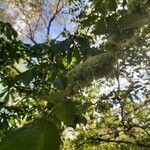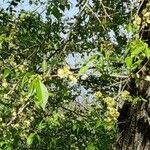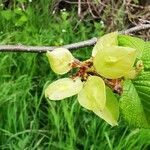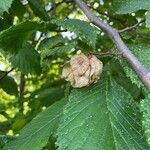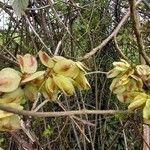Trees , to 40 m; trunks often multiple; crowns spreading, broadly rounded or ovate. Bark gray, smooth, furrowed with age. Wood hard. Branches spreading to pendulous, glabrous, branchlets lacking corky wings; twigs ash-gray to red-brown, villous when young. Buds obtuse; scales reddish brown, glabrous to marginally white-ciliate. Leaves: petiole 2-7 mm, densely villous. Leaf blade elliptic to obovate, (4-)7-14(-16) × (3-)4.5-8(-10) cm, base strongly oblique with lowermost lobe strongly overlapping, covering petiole, margins doubly serrate, apex long-acuminate to cuspidate, sometimes with 3 acuminate lobes at broad apex; surfaces abaxially pale green, villous with woolly tufts in vein axils, adaxially dark green, strigose to scabrous, margins not ciliate. Inflorescences dense fascicles, 8-20-flowered, less than 2.5 cm, flowers and fruits not pendulous; pedicel short, 0.4-0.8 mm, densely pubescent. Flowers: calyx lobed to ca. 1/2 length, lobes 4-8, reddish pubescent; stamens 5-6, purplish; stigmas reddish, with white pubescence. Samaras light greenish brown, elliptic to obovate with blunt or rounded tip, 1.5-2.5 × 1-1.8 mm, broadly winged, pubescent only along central vein of wing, apical cleft minute, obscured by persistent, curved styles. Seeds thickened, not inflated. 2 n = 28.
More
A large tree. It grows 30 m high. It has a wide spreading crown. It does not form suckers. The leaves are alternate and have double teeth around the edge. The leaves are 8-16 cm long. The base is unequal. The leaves are dull, dark green. The leaves turn a distinctive yellow in autumn. The leaves are rough above. The flowers are small and purplish. The fruit are winged and in clusters. The seed is larger than English elm.
It is a temperate plant. It will grow in most well-drained soils. It needs an open, sunny position. It is hardy to frost but affected by drought. It suits hardiness zones 5-9. At Anvers Chocolate factory. Arboretum Tasmania.
More
Woods, hedges and by streams, commoner in the west and north.
